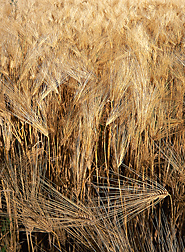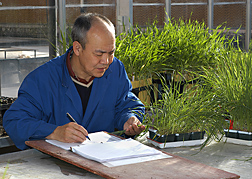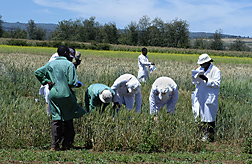World Wheat Supply Threatened!
Luckily, research is under way
to defend this grain of life.
A new wheat stem rust strain is on a worldwide march, threatening a global food problem and wheat shortage on a scale unknown since the 1950s. At that time, a strain of stem rust reached epidemic proportions and destroyed 40 percent of the spring wheat crop in North America.
The fungal disease—which also threatens barley—has now jumped the Red Sea, from east Africa to Yemen on the Arabian Peninsula, and is perfectly positioned to move on to Egypt, the Middle East, and Asia.
At the same time, Yue Jin, a plant pathologist at the Agricultural Research Service’s Cereal Disease Laboratory (CDL) in St. Paul, Minnesota, has confirmed that a new variant of the already virulent pathogen has occurred in Kenya, one that could broaden the disease’s reach to beyond the 80 percent of the world’s wheat already at risk.
All this is occurring at a low point in world wheat supplies. The Middle East and Asia’s 160-plus million acres of fields, which account for a quarter of the word’s annual wheat harvest, are in the direct path of the disease’s advance. And the spores of this fungal disease of plants could reach our continent sooner or later.
Global Cooperation
The Global Rust Initiative was formed in 2005 to fight the disease. Two international organizations—CIMMYT (Centro Internacional de Mejoramiento de Maíz y Trigo, or the International Maize and Wheat Improvement Center), based in El Batan, Mexico, and ICARDA (International Center for Agricultural Research in the Dry Areas), based in Aleppo, Syria—are leading the initiative, and ARS has been a supporter from the start. Governments and other research institutions in Australia, Canada, India, Egypt, Ethiopia, Iran, Kenya, South Africa, Sudan, Turkey, Uganda, and Yemen are joining the initiative’s efforts to address the current crisis.
Rick Ward, a wheat breeder from CIMMYT, coordinates the initiative from offices in El Batan. He says that in the beginning he realized how “incredibly close we came to not being prepared to deal with this crisis. The line of defense was incredibly thin.”
As the only facility in the United States that can identify various forms of stem rust and other cereal rusts, CDL is helping to jump-start the international effort to deal with the stem rust threat.
Stem rust is the worst of three fungal rust diseases that infect wheat. It grows mostly in the plant stem, destroying stem tissue so that carbohydrates can’t get from the leaves to the grains, which then shrivel. The diseases are called “rusts” because of the powdery, reddish-orange spores that form on infected plants.
Keeping the Revolution “Green”
The launch of the Global Rust Initiative was spurred by Norman E. Borlaug, the CIMMYT researcher who won a Nobel Prize in 1970 for breeding high-yielding wheat varieties with resistance to stem rust. Borlaug realized that the new stem rust mutant threatened to undo the successes of the so-called Green Revolution of the 1960s that, with ARS’s help, ushered in a 40-year era of dependable high yields of wheat to feed the world.
Edward B. Knipling, who heads ARS, agreed to help the rust initiative with start-up money and expertise. ARS would screen wheat collections and currently grown U.S. varieties for resistance to the new strain of stem rust in east Africa. Called “Ug99” for its discovery in Uganda in 1999, it is caused by the fungus Puccinia graminis f. sp. tritici.
ARS has worked with the National Wheat and Barley Improvement Committees to collect and send U.S. wheat and barley breeding lines to east Africa for screening against Ug99 in collaboration with CIMMYT and the Kenyan Agricultural Research Institute (KARI). Data from the Kenyan field-screening nursery will give U.S. wheat and barley breeders a headstart on developing new varieties with resistance to Ug99.
Interest in the effort is growing, helped in part by the results to date shown by Jin and colleagues at ARS, CIMMYT, ICARDA, KARI, the Ethiopian Institute of Agricultural Research, the University of Minnesota, and many other institutions.
At the end of 2006, Jin confirmed that a new variant of Ug99 has occurred in Kenya and is even more virulent—it defeated resistance gene Sr24, putting even more wheat varieties in danger. “We have to closely monitor for new forms of stem rust to make sure they cannot overcome the resistance genes we plan to introduce into wheat varieties,” says Jin.
CDL scientists have safeguarded and maintained a collection of rust strains, including stem rust, from domestic and international sources over the past 50 years. That, together with long-conserved, ARS-managed collections of wheat germplasm lines at Aberdeen, Idaho, is invaluable to researchers. (See story “RUSTPROOF! Idaho Experts Search for Stem-Rust-Resistant Wheat” in this issue.)
|
|
Watching Our Southern Flank
ARS and wheat breeders from southern states are targeting a “southern strategy.” Kay Simmons, ARS national program leader for plant genetics and grain crops, explains that ARS is helping to develop increased genetic protection for the entire United States, but especially in the southern states—such as Texas, Louisiana, and Georgia—where stem rust is able to survive through winter. Jin explains that high levels of Ug99 resistance developed and deployed in the southern states could prevent Ug99 from taking hold there and spreading to the rest of the country.
Nationally, ARS scientists and university cooperators have planted susceptible and resistant wheat varieties at multiple locations around the country to monitor for new and emerging rust strains. Such outdoor plantings are used to provide early warnings of cereal rust disease for both researchers and producers.
|
|
Counting on Resistance Genes
In 2005 and 2006, greenhouse studies at CDL and field studies in both Kenya and Ethiopia showed that Ug99 had overcome most of the known stem rust resistance genes deployed in wheat cultivars over the years. Instrumental in this critical work were Jin, CDL research leader Marty Carson, wheat breeder and geneticist Ravi P. Singh of CIMMYT, and wheat researchers in Kenya and Ethiopia.
ARS is working with the U.S. wheat and barley breeders to identify and apply DNA marker technology to deploy effective resistance genes into every major class of U.S. wheat and barley.
The four ARS regional small-grains genotyping laboratories are now focused on the wheat classes grown in their regions: hard red spring wheat and durum wheat at Fargo, North Dakota; hard red winter wheat at Manhattan, Kansas; soft red winter wheat at Raleigh, North Carolina; and soft white winter wheat at Pullman, Washington.
For this work, ARS is partnering with U.S. breeders through the National Wheat and Barley Improvement Committees. A priority is to develop breeder-friendly DNA markers to locate genes effective against Ug99 and deploy them into wheat and barley cultivars.
At the Raleigh lab, for example, ARS geneticist Gina Brown-Guedira is targeting three genes effective against Ug99 that have not been used widely in U.S. wheat—Sr22, Sr25, and Sr40—for transfer into advanced breeding lines of soft winter wheat supplied by breeders. These genes are being pyramided with two effective resistance genes—Sr36 and an unnamed rye gene that is already present in soft winter wheat germplasm.
Singh and other CIMMYT breeders are coordinating the transfer of genes from resistant spring wheat lines to CIMMYT breeding lines. They identify resistant wheats by planting them in screening nurseries in east Africa. Then the seed is brought to Mexico to grow the next generation of plants. Still further generations are then grown in Africa to test against Ug99 and in Mexico for final selection. The next crop season, they test to be sure yields are adequate. ICARDA is carrying out similar work.
Resistant selections are distributed to U.S. wheat breeders through international nursery systems. At CDL, Jin helps to determine what genes are present in these materials by testing them with multiple stem rust races at the seedling stage. Experiments on Ug99 are done by exposing seedlings in special greenhouses and plant growth chambers in midwinter in St. Paul, when the weather is too cold for any possible escaping spores to survive.
Les Szabo, an ARS geneticist at CDL, has helped create a genetic map of the Ug99 fungus’s genome. This will help researchers build a diagnostic kit to quickly identify new forms of the disease in fields and find resistance genes faster in wheat.
Training Is the Key
The Global Rust Initiative is training scientists around the world to recognize stem rust and understand ways to prevent it and strategies for breeding resistant wheat.
“We want to enhance the knowledge of contemporary genetic techniques in Ethiopia, Kenya, and other countries,” Ward says. “We also want to support efforts in those countries to breed wheat varieties that will resist Ug99 and other rusts.”
It was a CIMMYT-trained researcher in Uganda who first spotted the new form of stem rust on wheat in fields at a research station in 1998.
“Had we not had people like him trained in over 90 countries, we might not have spotted Ug99 until years later,” Ward says.
And Simmons agrees. “It is in the interests of the United States to have such trained people in other countries to extend our early-warning lines of defense worldwide.”—By Don Comis, Agricultural Research Service Information Staff.
This research is part of Plant Diseases, an ARS national program (#303) described on the World Wide Web at www.nps.ars.usda.gov.
To reach scientists mentioned in this article, contact Don Comis, USDA-ARS Information Staff, 5601 Sunnyside Ave., Beltsville, MD 20705-5129; phone (301) 504-1625, fax (301) 504-1486.
"World Wheat Supply Threatened!" was published in the November/December 2007 issue of Agricultural Research magazine.











